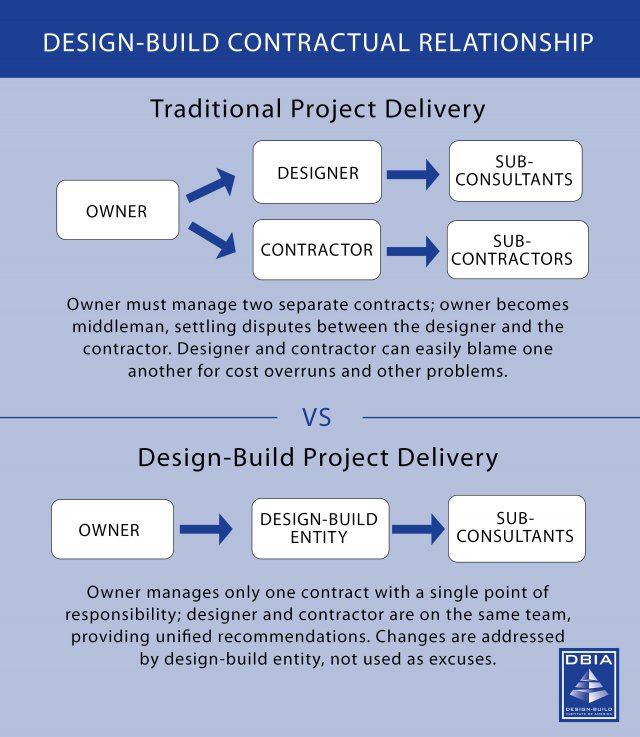Design and Build Approaches for Green Streets
On this page:
- Design-Build Process
- Alternative Design Approaches
- Design with Maintenance in Mind
- Design and Build Tools and Resources
- City Design Manual
Design-Build Process
The Design-Build process is a more comprehensive, streamlined approach to construction, particularly a green street. According to the Design Build Institute of America. "Design-Build" is a method of project delivery in which one entity – the Design-Build team – works under a single contract with the project owner to provide both design and construction services – thereby integrating the roles of designer and constructor. Design-Build is an alternative to the traditional design-bid-build project delivery method which utilizes separate entities and separate contracts for the design and construction of a project.
Across the country and around the world, Design-Build successfully delivers both horizontal (e.g., roadways) and vertical (e.g., buildings) construction projects with superior results – no matter what the project type. Design-Build successfully delivers office buildings, schools, stadiums, transportation and water infrastructure projects with superior results. Over the past 15 years, use of the Design-Build process has greatly accelerated in the United States, making this delivery method one of the most significant trends in design and construction today. By using the Design-Build approach to create a green street, the end result will ultimately be Faster, Cheaper, and Greener.

In addition to being a more comprehensive, streamlined approach, the Design-Build process is uniquely suited to help building projects achieve sustainability goals. In late 2013, the United States Green Building Council (USGBC) reaffirmed this when they released a new version of the Leadership in Energy and Environmental Design (LEED®) v4 green building rating system that includes a credit toward certification for integrative project delivery.
The Design-Build process has five primary phases:
- Selecting a Design-Builder
- Pre-construction assessments
- Architectural Design
- Construction
- Post-Construction
Alternative Design Approaches
G3 also encourages the use of green infrastructure design competitions to introduce local designers, engineers, architects, and landscape architects to the integration of sustainable design practices for stormwater management through green infrastructure. Design competitions are innovative and proven to be successful in teaching professionals that green infrastructure and other sustainable practices can be incorporated in the development of a project with greater costs savings and increased aesthetical value. Featured design competitions include the City of Philadelphia’s “Soak it UP” Competition and Houston’s Low Impact Design Competition .
For additional information on green infrastructure designing and building your green street, please visit EPA's Green Infrastructure page.
Design with Maintenance in Mind
To maximize the environmental benefits and reduce to the cost of green infrastructure projects over the long-term, green infrastructure projects should be designed with maintenance in mind. For green infrastructure projects to capture and infiltrate stormwater onsite and perform as expected, there are several factors to consider before project implementation.
- Type of maintenance to be performed
- Frequency of maintenance and available personnel to perform maintenance
- Cost of component replacement (e.g., plants, shrubs, permeable pavement)
- Sufficient and dedicated funds to cover operation and maintenance (O&M) activities, including cost of replacement components
Design and Build Tools and Resources
- EPA's A Conceptual Guide to Effective Green Street Design Solutions (PDF)(7 pp, 5.7 MB) This guidebook discusses the different types of green street opportunities in your community, such as residential streets, commercial streets, arterial streets and alleys and the opportunities they may have to manage stormwater at its source.
- EPA's National Stormwater Calculator is a desktop application that estimates the annual amount of rainfall and frequency of runoff from a specific site anywhere within the United States (including Puerto Rico). Estimates are based on local soil conditions, land cover, and historic rainfall records.
- EPA's Design Manuals are a collection stormwater design manuals from states, counties, municipalities, and nonprofits across the United States and Canada that emphasize green infrastructure approaches. Each manual includes a detailed design guideline tailored to the local physical and regulatory landscape and planning and design approaches, as well as structural stormwater controls.
- The Real Cost of Green Infrastructure - This article published by the Water Environment Federation (WEF) discusses ways to reduce capital costs and plan more effectively for long-term operations and maintenance (O&M) for green infrastructure projects.
City Design Manuals
- City of Philadelphia's Green Street Design Manual (PDF)(96 pp, 38.7 MB)
- Dallas Complete Streets Initiative and Design Manual (PDF)(252 pp, 23.5 MB)
